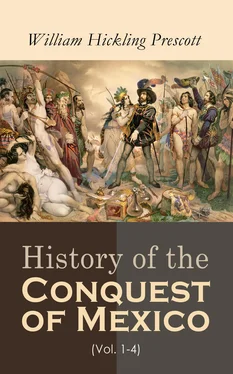Their military code bore the same stern features as their other laws. Disobedience of orders was punished with death. It was death, also, for a soldier to leave his colors, to attack the enemy before the signal was given, or to plunder another’s booty or prisoners. One of the last Tezcucan princes, in the spirit of an ancient Roman, put two sons to death—after having cured their wounds—for violating the last-mentioned law. [93]
I must not omit to notice here an institution the introduction of which in the Old World is ranked among the beneficent fruits of Christianity. Hospitals were established in the principal cities, for the cure of the sick and the permanent refuge of the disabled soldier; [94]and surgeons were placed over them, “who were so far better than those in Europe,” says an old chronicler, “that they did not protract the cure in order to increase the pay.” [95]
Such is the brief outline of the civil and military polity of the ancient Mexicans; less perfect than could be desired in regard to the former, from the imperfection of the sources whence it is drawn. Whoever has had occasion to explore the early history of modern Europe has found how vague and unsatisfactory is the political information which can be gleaned from the gossip of monkish annalists. How much is the difficulty increased in the present instance, where this information, first recorded in the dubious language of hieroglyphics, was interpreted in another language, with which the Spanish chroniclers were imperfectly acquainted, while it related to institutions of which their past experience enabled them to form no adequate conception! Amidst such uncertain lights, it is in vain to expect nice accuracy of detail. All that can be done is to attempt an outline of the more prominent features, that a correct impression, so far as it goes, may be produced on the mind of the reader.
Enough has been said, however, to show that the Aztec and Tezcucan races were advanced in civilization very far beyond the wandering tribes of North America. [96]The degree of civilization which they had reached, as inferred by their political institutions, may be considered, perhaps, not much short of that enjoyed by our Saxon ancestors under Alfred. In respect to the nature of it, they may be better compared with the Egyptians; and the examination of their social relations and culture may suggest still stronger points of resemblance to that ancient people.
Those familiar with the modern Mexicans will find it difficult to conceive that the nation should ever have been capable of devising the enlightened polity which we have been considering. But they should remember that in the Mexicans of our day they see only a conquered race; as different from their ancestors as are the modern Egyptians from those who built,—I will not say, the tasteless pyramids,—but the temples and palaces whose magnificent wrecks strew the borders of the Nile, at Luxor and Karnac. The difference is not so great as between the ancient Greek, and his degenerate descendant, lounging among the masterpieces of art which he has scarcely taste enough to admire,—speaking the language of those still more imperishable monuments of literature which he has hardly capacity to comprehend. Yet he breathes the same atmosphere, is warmed by the same sun, nourished by the same scenes, as those who fell at Marathon and won the trophies of Olympic Pisa. The same blood flows in his veins that flowed in theirs. But ages of tyranny have passed over him; he belongs to a conquered race.
The American Indian has something peculiarly sensitive in his nature. He shrinks instinctively from the rude touch of a foreign hand. Even when this foreign influence comes in the form of civilization, he seems to sink and pine away beneath it. It has been so with the Mexicans. Under the Spanish domination, their numbers have silently melted away. Their energies are broken. They no longer tread their mountain plains with the conscious independence of their ancestors. In their faltering step and meek and melancholy aspect we read the sad characters of the conquered race. The cause of humanity, indeed, has gained. They live under a better system of laws, a more assured tranquillity, a purer faith. But all does not avail. Their civilization was of the hardy character which belongs to the wilderness. The fierce virtues of the Aztec were all his own. They refused to submit to European culture,—to be engrafted on a foreign stock. His outward form, his complexion, his lineaments, are substantially the same; but the moral characteristics of the nation, all that constituted its individuality as a race, are effaced forever.
Two of the principal authorities for this chapter are Torquemada and Clavigero. The former, a Provincial of the Franciscan order, came to the New World about the middle of the sixteenth century. As the generation of the Conquerors had not then passed away, he had ample opportunities of gathering the particulars of their enterprise from their own lips. Fifty years, during which he continued in the country, put him in possession of the traditions and usages of the natives, and enabled him to collect their history from the earliest missionaries, as well as from such monuments as the fanaticism of his own countrymen had not then destroyed. From these ample sources he compiled his bulky tomes, beginning, after the approved fashion of the ancient Castilian chroniclers, with the creation of the world, and embracing the whole circle of the Mexican institutions, political, religious, and social, from the earliest period to his own time. In handling these fruitful themes, the worthy father has shown a full measure of the bigotry which belonged to his order at that period. Every page, too, is loaded with illustrations from Scripture or profane history, which form a whimsical contrast to the barbaric staple of his story; and he has sometimes fallen into serious errors, from his misconception of the chronological system of the Aztecs. But, notwithstanding these glaring defects in the composition of the work, the student, aware of his author’s infirmities, will find few better guides than Torquemada in tracing the stream of historic truth up to the fountain-head; such is his manifest integrity, and so great were his facilities for information on the most curious points of Mexican antiquity. No work, accordingly, has been more largely consulted and copied, even by some who, like Herrera, have affected to set little value on the sources whence its information was drawn. (Hist. general, dec. 6, lib. 6, cap. 19.) The Monarchía Indiana was first published at Seville, 1615 (Nic. Antonio, Bibliotheca Nova (Matriti, 1783), tom. ii. p. 787), and since, in a better style, in three volumes folio, at Madrid, in 1723.
The other authority, frequently cited in the preceding pages, is the Abbé Clavigero’s Storia antica del Messico . It was originally printed towards the close of the last century, in the Italian language, and in Italy, whither the author, a native of Vera Cruz, and a member of the order of the Jesuits, had retired, on the expulsion of that body from Spanish America, in 1767. During a residence of thirty-five years in his own country, Clavigero had made himself intimately acquainted with its antiquities, by the careful examination of paintings, manuscripts, and such other remains as were to be found in his day. The plan of his work is nearly as comprehensive as that of his predecessor, Torquemada; but the later and more cultivated period in which he wrote is visible in the superior address with which he has managed his complicated subject. In the elaborate disquisitions in his concluding volume, he has done much to rectify the chronology and the various inaccuracies of preceding writers. Indeed, an avowed object of his work was to vindicate his countrymen from what he conceived to be the misrepresentations of Robertson, Raynal, and De Pau. In regard to the last two he was perfectly successful. Such an ostensible design might naturally suggest unfavorable ideas of his impartiality. But, on the whole, he seems to have conducted the discussion with good faith; and, if he has been led by national zeal to overcharge the picture with brilliant colors, he will be found much more temperate, in this respect, than those who preceded him, while he has applied sound principles of criticism, of which they were incapable. In a word, the diligence of his researches has gathered into one focus the scattered lights of tradition and antiquarian lore, purified in a great measure from the mists of superstition which obscure the best productions of an earlier period. From these causes, the work, notwithstanding its occasional prolixity, and the disagreeable aspect given to it by the profusion of uncouth names in the Mexican orthography, which bristle over every page, has found merited favor with the public, and created something like a popular interest in the subject. Soon after its publication at Cesena, in 1780, it was translated into English, and more lately into Spanish and German.
Читать дальше












